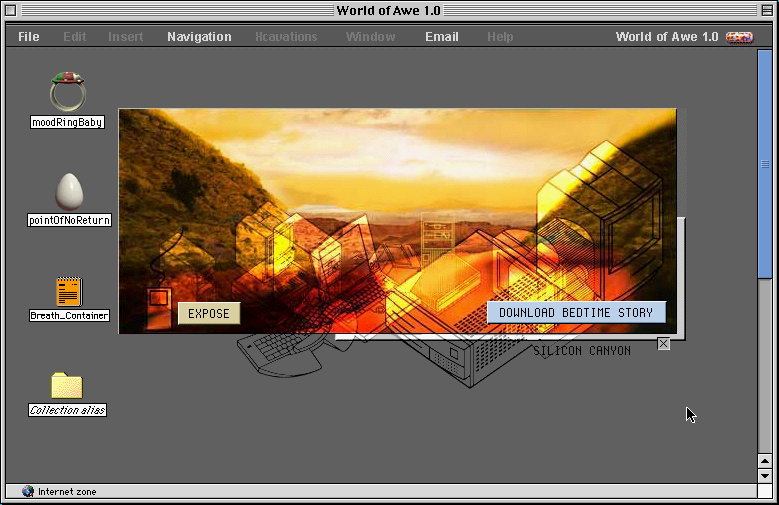This interview accompanies the presentation of Yael Kanarek’s World of Awe: The Traveler’s Journal (Chapter 1: Forever) as a part of the online exhibition Net Art Anthology.
Kaela Noel: How, and when, did World of Awe originate?
Yael Kanarek: World of Awe originated in a series of acrylic paintings in 1994, right after my first group show at The Drawing Center. I stood in front of my gouache works of fantastical domestic scenes—women with penises instead of breasts, men with tails spinning cups, etc.—and felt that they weren’t authentic. (I feel differently about them now, though.) I felt as if I didn’t know who I was as an artist. I went home and made a list of things I loved and decided to work through them. In my early twenties, I worked in portraiture. I began to move away from it when I came to New York and completely departed from any prior conventions about painting with the World of Awe series. Then love letters started to appear in the paintings. I never imagined that language would become such a central theme for me. I always found language to be very difficult and menacing. I still do. These paintings became a portal to another world and a new life. They are very dear to me.
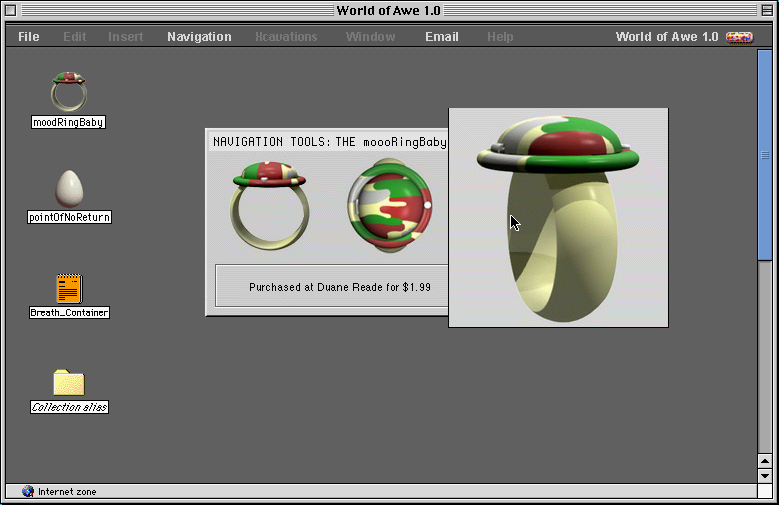
Yael Kanarek, World of Awe: The Traveler's Journal (Chapter 1: Forever), 2000. Screenshot created in EaaS using IE4.5 for Mac.
KN: Was it your first online artwork?
YK: My first net artwork was Love Letters from a World of Awe back in 1995. It’s still online. Very early experiments with storytelling, digital image-making, virtual/physical feedback loops, animation, and interactivity. It reflects some of the ideas and problems we were thinking about in the mid-90s. Sometimes I show it to students when I teach “Art in the Cloud” through Pratt’s MFA program as a crash course in HTML/CSS for artists.
KN: How did you come to make work on the web, specifically browser-based works? Were you part of a wider group or network of artists involved with the web in the 1990s? How did you communicate and discover other works of net art?
YK: I was freelancing at a travel service on Broadway below Houston. One of the owners kept talking about this “information superhighway” but couldn’t quite explain what it was. He did know he wanted the company to have a website. I was desperate to learn a paying skill and very intrigued by the office computer, so I offered to take it on. Funny enough, the company’s website was included in a book called Shopping on the Internet published in 1995. Razorfish had just figured out how to push images with a Perl script that created these animations that blew everybody’s minds. And then I discovered their office was in the next building. One day at lunch, I went over, knocked on their door, and said hello.
KN: What happened when they answered?
YK: We had an excited conversation about this new internet thing and wondered whether Craig Kanarick (one of Razorfish’s owners) and I were lost relatives from the old country of Eastern Europe. Razorfish was attracting artists and culture makers all around them. Making art is a great state of mind for experimentation because it allows for pure play. They understood that. Later, they hosted Chapter 1 of World of Awe on their curated website The Blue Dot.
My second freelance job was in the music industry as a website creator, before coding and design separated completely. Mark Tribe [founder of Rhizome] came by one day to visit a co-worker. He was talking about Rhizome. Between the Razorfish folks, Mark Tribe’s Rhizome, and John Johnson of Eyebeam, I joined a very exciting international community with a strong base in downtown New York City. John was an especially generous benefactor who enabled a lot of new work and experimentation to emerge. There was an air of new, an air of an enormous revolution.
Recently, I heard a recording of Rauschenberg talking about the artists’ community and sense of experimentation they shared in the ‘70s. I feel fortunate to say that I identify with that sentiment, in that it resonates with my experiences in the mid-90s. Although I was born in New York, I left as a toddler. By the time I returned in 1991 I was practically, culturally, an immigrant. This experimental environment Rauschenberg talks about, a community that was open to invention, this was something I had dreamed about since I was sixteen.
I created two net art versions of World of Awe, one in 1995 and a second in 1997. Then I needed a break, to retreat into my little cave. I wanted to learn more about World of Awe, specifically the Traveler’s Journal. So I spent 1998 writing letters and travelogues, defining the physical properties and geography of Sunset/Sunrise, and creating the dynamics between the Traveler and the Lover, whose genders remain ambiguous. I researched early forms of graphical user interface (GUI) and UX and studied the various reasonings (psychological, cognitive) behind the desktop story. I read travelogues and classic literature, played computer games, and thought about gender in language. This yearlong effort resulted in the “emulator” of the Traveler’s fictional laptop built in Silicon Canyon from scraps of older computers. (The laptop is described in greater detail in Chapter 2 > Navigation > Tools > Laptop.) The laptop “emulator” delivers the Traveler’s writings through GUI, which is an integral part of the narrative. Christiane Paul included it in the 2002 Whitney Biennial.
While working on this piece, I felt quite isolated. One night I invited a few artists I saw on the Rhizome list to meet at a bar in the East Village. Mark Napier, Tim Whidden, and Michael Sarff came. It was great to hangout in person and I took it upon myself to organize monthly meetings. A few months later, I approached Liz Slagus at Eyebeam and asked if they could support us. They gave us access to a room, computer, and projector, and the Upgrade! Network was born.
The network ran for about a decade with many nodes around the world and four international festivals. Many of the artists who were active during that decade either spoke, organized, or attended Upgrade! meetings. Upgrade! Paris was probably the longest running node. Unfortunately, Eyebeam lost most of the archived material, but I kept the original version of the site: http://www.theupgrade.net/.
Many of us made net art, wrote about net art, organized events, and curated shows all about net art. I volunteered to redesign the Whitney Artport among other projects. During my short stint as a senior web designer at theglobe.com, I curated three online exhibitions in their net art gallery, Pixel, which I initiated.
As a community, we were involved in making the work and framing it. And then the dot-com bubble exploded in 2002. That, in my experience, brought an era to a halt. While online business investment recovered, investment in net art hasn’t for many years. There was barely any institutional support, except for Turbulence.org and Rhizome, who kept giving small grants. And, at least in the United States, museums lost their funding for new media. It seems like it took a decade for net art culture to reemerge, which happened when the Myspace generation came of age with Web 2.0 sensibilities.
KN: Chapter 1 was originally accompanied by “Nowheres”: http://worldofawe.net/nowheres/. Why did you keep these outside of the project?
YK: I don’t have a clear answer. It could have been a change in zeitgeist or browser version compliance or both. All the pieces of this project belong together. And lately I’ve been grappling with an even bigger question: How do I present all the works that make World of Awe, as some are net art and many others are documentation of physical works, performance, and publications? The line between net art and documentation blurs awkwardly online. It’s a curatorial and UX challenge. I’m open to suggestions.
I worked on my last solo exhibition, Kisses Kisses, at bitforms in 2016 with co-curators Kerry Doran (then-Associate Director at bitforms) and Dylan Kerr (then-Editor at Artsy). Together we looked back at the early days of World of Awe, cataloguing all the works in storage, climbing to out-of-reach closet cabinets, and opening forgotten drawers. We found earlier works on paper from 1994 that looked like SMS bubbles in a trash bag. My two old Mac towers with local internet versions of World of Awe were in perfect condition and fully functioning. I completed a previously unfinished project “Activity Book” I started in the late ‘90s and bitforms published it as a zine for the exhibition, including an essay by Kerry and interview with Dylan.
This exhibition of World of Awe was the first full manifestation of physical world building that I originally intended in 1995. The idea was that the world can be curated in various ways to create different experiences, highlighting multiple threads of the project. Kisses Kisses happened because the curators became collaborators on the project, creating an installation that was another iteration of the World of Awe.
Regarding “Nowheres,” they exist in three forms: (1) the digital landscapes; (2) A Library of Maps; and (3) high-quality digital prints. I worked with Alex Galloway on A Library of Maps, which gathers user tracking data and then randomly superimposes that data over a Nowhere image. The prints were 3D desert landscapes with users’ tracking data hand-drawn on top of them. I filtered the data using various parameters, such as the first minute of every day over a certain period of time.
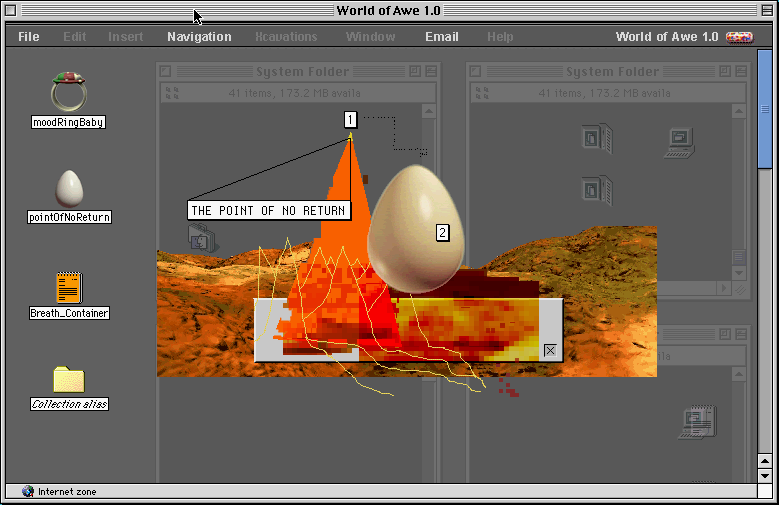
Yael Kanarek, World of Awe: The Traveler's Journal (Chapter 1: Forever), 2000. Screenshot created in EaaS using IE4.5 for Mac.
KN: Silicon Canyon, the terrain explored by the narrator, appears to be a futuristic version of Silicon Valley, in which planned obsolescence and environmental destruction have created a junk-littered dystopian desert. Did you mean for this setting to critique how tech culture encourages progress without preservation or resource protection?
YK: I was thinking about several “what ifs” and placing them in a future-past non-time, evoking nostalgia for first-generation home computers. I started experiencing a technological dystopia after I dumped my third tube screen and tried to not think about where all this electronic garbage was going. When I wrote Silicon Canyon, I wasn’t aware of the mountains of digital debris dumped in other parts of the planet. This shit we love so much goes somewhere when we’re done with it and it’s an ecological problem.
Another “what if” sounded like this: Let’s say I’m an alien archaeologist who comes across Silicon Canyon. Studying these hills of hardware and uncompiled software in the form of airborne strings of letters, what would I know about the culture that made it?
Like many of us, I have a growing pile of computers and old electronics—my own Silicon Canyon. I showed my first computer at Kisses Kisses. It ran the Speaker Tree sculpture. The first time I turned it on, it worked, both computer and screen. But just before the exhibition opening, the screen’s brittle plastic buttons broke and I don’t know if it was the screen or the computer that failed. We hacked the piece with an old MP3 player. Then the second Windows machine died. It ran Roam, a generative 3D landscape. Then we “upgraded” it to an old Dell laptop. Working with old technology, you just learn to accept potential system failure and always plan to improvise.
KN: What are your thoughts on the unchecked decay of software and hardware, and the wider impact of Silicon Valley and its inventions on the ecosystem?
YK: When do we start sending our crap to outer space? The universe is big.
KN: I’m curious about 419 East 6th Street, the Manhattan address hosting the “portal” through which World of Awe’s treasure-seeking traveler passes into Sunset/Sunrise. Did you pick the address randomly, or does it have some significance? (I know it’s next door to Walter De Maria’s house/studio.)
YK: I was looking for a physical “nowhere” for the portal. 419 isn’t an address on East 6th. There’s a 417 and 421. But 419 was a gated empty lot, the air space around the enormous building that was a Con Edison substation. Only later did I learn it belonged to Walter De Maria. Apparently, Peter Brandt just bought the building and is renovating it to house his collection. I might be able to visit the portal if it opens to the public.
One collaboration that focused on the portal was the 2003 net.dance piece commissioned by Turbulence.org. The project features dancer and filmmaker Evann Siebens with music by Yoav Gal. Over the years, though, it started to suffer from version-decay. Someone at Turbulence.org made a video of it.
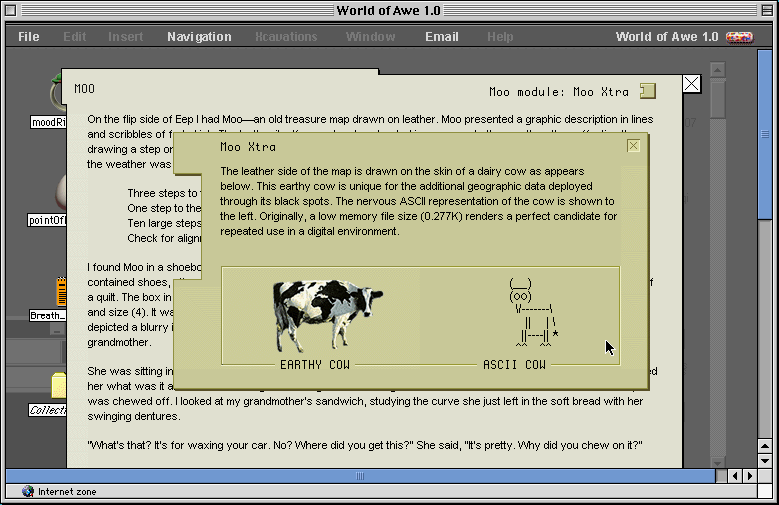
Yael Kanarek, World of Awe: The Traveler's Journal (Chapter 1: Forever), 2000. Screenshot created in EaaS using IE4.5 for Mac.
KN: Can you talk about the special maps the Traveler consults? “Moo,” the leather map, made me think of MOOs. How did you pick the names for it and its digital counterpart, the map “Eep”?
YK: I was aware of MOOs so the association was cool. I was thinking of sounds and I needed short nicknames to refer to the two sides of the map. “Eep” is one of the original Mac OS alert sounds. A cow’s “moo,” with its deeper resonance, counters the more high-pitched “eep.” Digital and animal sounds—the connection between “Eep” and “Moo” is very special and intertwined. The two maps are attached at their backs with electro-organic glue. The Traveler wrote that separating them sounds like the screech of a dying animal. Perhaps similar to the cry of a child who’s forced to separate from their smartphone.
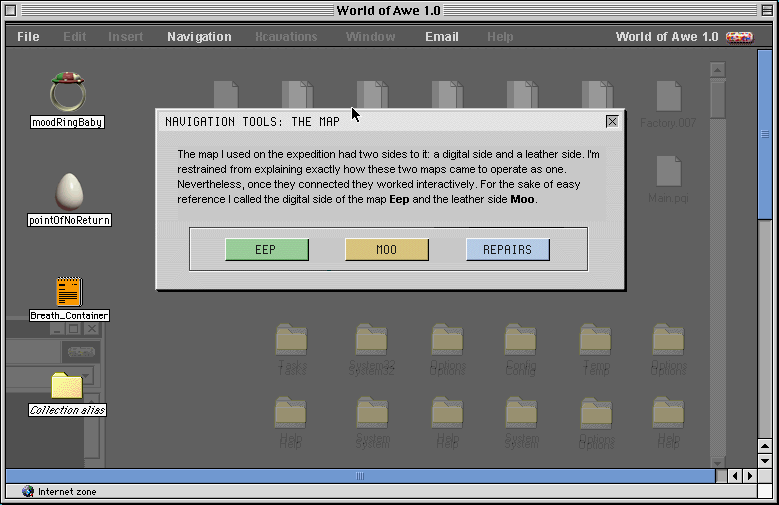
Yael Kanarek, World of Awe: The Traveler's Journal (Chapter 1: Forever), 2000. Screenshot created in EaaS using IE4.5 for Mac.
KN: Can you discuss Sunset/Sunrise and World of Awe as virtual worlds on the web?
YK: World of Awe refers to the whole, the world which holds all the work, physical and virtual. Sunset/Sunrise is the parallel world described by the Traveler and where the treasure hunt takes place. The impulse to bring the story to the web was twofold. One was practical, since I ran out of space in my studio/bedroom. The second reason was total fascination with this technological network that uses metaphors of space and navigation to enable action. The story of the internet as a boundless, nonlinear space was a perfect setting for Sunset/Sunrise—where time is suspended, gravity is optional, water is inessential, and treasure crumbs resemble candy sprinkles.
Once the internet became a multilingual space and supported many more languages, I started thinking about it as a space of language, both computer and spoken. Languages define borders and space on the internet. It was natural for me to ask how can Sunset/Sunrise cross these borders and how can I fold these language spaces into the treasure hunt.
These questions opened the door to World of Awe’s third chapter Object of Desire, written in English, Hebrew, and Arabic, with additional Romanesque words and C++ for a sesame cookie recipe. Object of Desire took three years and significant support. I had a fully funded MFA at Rensselaer Polytechnic Institute (RPI), a Rockefeller Media fellowship, a scheduled exhibition at the Jewish Museum, and the back of bitforms gallery in order to make it happen.
Object of Desire took the Traveler’s Journal to the Mediterranean and Middle East. The fifteen scenes are based on themes and motives born in the region that are alive in contemporary culture. In the third chapter, the landscape takes over the whole window. We move through the landscape in HyperCard-style following a series of arrows. I made it in Flash. A big risk, but I figured that as long as advertising, video streaming sites, and Facebook use the technology, the work is safe from dying. The only problem right now is that screen resolutions are increasing, so the work is becoming smaller on the screen. I recommend zooming in.
Working in a multilingual space has offered me the greatest learning curve. It’s also resulted in an ongoing body of works called TextWorks. Working with multiple languages doesn’t allow for drifting. It keeps you on earth and not off into another world or inner mindspace. Geography, politics, trade, history, conquest, sex, all of these are at play and are constantly evaluated in this context. Meaning divides and shapeshifts like water.
KN: In Chapter 3, you address globalization, national identity, and language in the context of the web. The work spans three languages—Arabic, Hebrew, and English—and is the first chapter in the project that suggests a more explicitly political backdrop or aim. What are your thoughts on language’s role in net art and the internet, and borders? And on the generally Western-focused locus of net art? What were your aims with this chapter and what are your thoughts around it now?
YK: It wasn’t obvious to me that I would use these three languages. Several things motivated me. An immigrant, whether from overseas or another part of the country, never completely leaves the landscape of their childhood. Taking the Rosetta Stone as an inspirational model, I had a unique opportunity to dedicate a serious amount of time and resources to look at a deeply rich cultural well, one that’s centuries in the making. I didn’t see anyone make work across languages, and I knew I could. So I did.
During the first few years since Chapter 3’s launch in 2006, the scenes were downloaded from four different servers located in Izmir, Tel Aviv, Ramallah, and New York City. When you clicked on a scene, a note would show up indicating where the file was downloading from.
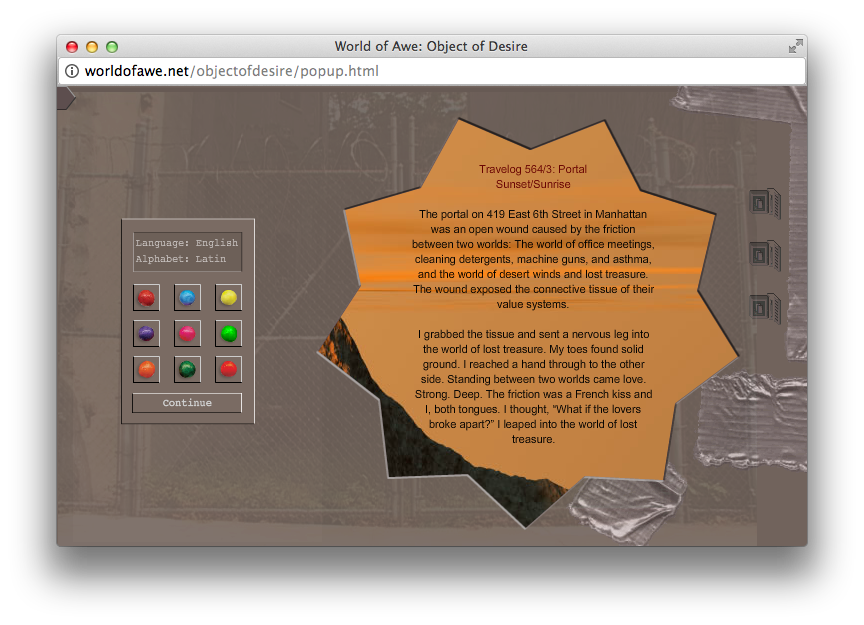
Yael Kanarek, World of Awe: Chapter 3 (Object of Desire), 2006
I also had to make a decision regarding gender. In English, I could keep the gender of the Traveler and Lover ambiguous. But Hebrew and Arabic don’t permit this. I had two options, either select a gender or do something to the languages. I chose to add an icon to the existing alphabets. The alphabet systems are similar. Both Hebrew and Arabic have a letter called Ayin, which means Eye. I added another icon of an eye and placed it where words became gender specific. The eye blinks and turns the gaze. The text is now looking at the reader. When it comes to gender, two eyes are better than one. Better depth of field. And a satisfying solution.
During my time working on the Arabic section with a translator, I experienced a crude political awakening to the living experience of Palestinians under the Israeli state and army. I had some awareness before, but didn’t understand what living under military occupation meant to ordinary people, nor what it meant to be a minority in the state. This resulted in an undoing of the education I received growing up in mainstream Israel. Painful, but critical.
KN: In working on the project as a whole, were you influenced by any existing platforms or online works, or did you pull more from outside sources, like literature and film?
I’m influenced by everything and not one to discriminate. I’m a sponge artist. I’ve always loved discoveries and tales of travel. There’s this yearning that drives World of Awe, the search for the lost treasure, and also a sense of loss for the Lover left behind. I read travelogues that spanned centuries, starting with the story of Gilgamesh. I was looking for writings from female travelers and came across the diaries of Isabelle Eberhardt, a young European woman who crossed gender, religious, and political borders in Algeria during the early 20th century. She died in a flash flood at age twenty-seven.
I was also attracted to small town American culture, which I was introduced to through my partner at the time. Quiet summer afternoons in California felt the same as the quiet summer afternoons of my childhood in Israel. Where the air feels like it's not moving and won't ever move again... Time stands still in those places. I also listened to a lot of American music, like Johnny Cash and the blues.
KN: What are you working on now?
YK: I’ve started working on the fourth chapter. The framework is conceptualized and I created the first piece for the exhibition Kisses Kisses. Creating Chapter 4 has me picking up on a thread I left in 1995, realizing now what I couldn’t then. The chapter will be a set of hand-coded, single page works. The only user interaction is clicking through to the page’s “View Source.” The pieces happen in the front and the source.
